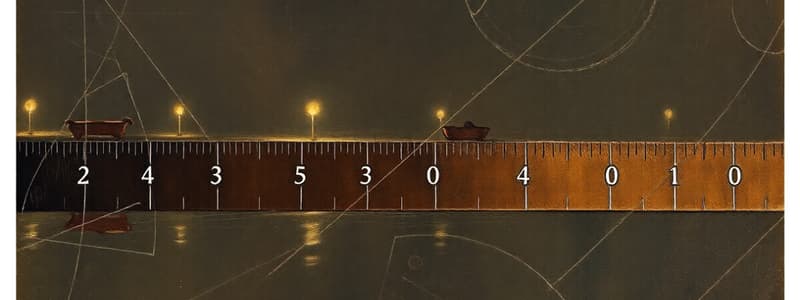Podcast
Questions and Answers
What type of energy is produced specifically by the motion of an object?
What type of energy is produced specifically by the motion of an object?
- Chemical Energy
- Kinetic Energy (correct)
- Thermal Energy
- Radiant Energy
Which type of energy is primarily associated with the random motion of particles?
Which type of energy is primarily associated with the random motion of particles?
- Mechanical Energy
- Thermal Energy (correct)
- Kinetic Energy
- Chemical Energy
What energy form is considered a type of potential energy due to atomic arrangements?
What energy form is considered a type of potential energy due to atomic arrangements?
- Kinetic Energy
- Radiant Energy
- Chemical Energy (correct)
- Thermal Energy
Which energy type serves as Earth's primary energy source?
Which energy type serves as Earth's primary energy source?
How is the quantity of chemical energy in a substance primarily determined?
How is the quantity of chemical energy in a substance primarily determined?
What is the proper scientific notation for the number of copper atoms in a penny?
What is the proper scientific notation for the number of copper atoms in a penny?
Which of the following correctly defines significant figures?
Which of the following correctly defines significant figures?
What is the first guideline concerning significant figures?
What is the first guideline concerning significant figures?
What are SI units, according to international standards?
What are SI units, according to international standards?
How many significant figures are present in the measurement 1.212 kg?
How many significant figures are present in the measurement 1.212 kg?
In terms of measurement, which component indicates the uncertainty of a value?
In terms of measurement, which component indicates the uncertainty of a value?
Which of these statements is true about zeros in a measurement?
Which of these statements is true about zeros in a measurement?
What action is needed to convert 28,000,000,000,000,000,000,000 to scientific notation?
What action is needed to convert 28,000,000,000,000,000,000,000 to scientific notation?
How many significant figures are in the measurement 0.0000349 g?
How many significant figures are in the measurement 0.0000349 g?
Which temperature scale is denoted by the symbol K?
Which temperature scale is denoted by the symbol K?
What is the primary distinction between mass and weight?
What is the primary distinction between mass and weight?
Which of the following is NOT a significant figure in the measurement 0.08 L?
Which of the following is NOT a significant figure in the measurement 0.08 L?
What unit is used to measure the amount of substance in the SI system?
What unit is used to measure the amount of substance in the SI system?
In the context of multiplication and division, how should significant figures be treated?
In the context of multiplication and division, how should significant figures be treated?
Which of the following best describes temperature?
Which of the following best describes temperature?
How many significant figures does the measurement 40,501 kg contain?
How many significant figures does the measurement 40,501 kg contain?
What does the symbol $△U$ represent in thermodynamics?
What does the symbol $△U$ represent in thermodynamics?
Which equation correctly expresses the relationship of change in internal energy in terms of heat and work?
Which equation correctly expresses the relationship of change in internal energy in terms of heat and work?
What is the unit of work in thermodynamics according to the provided content?
What is the unit of work in thermodynamics according to the provided content?
What must be done when converting units from atm·L to J according to the provided information?
What must be done when converting units from atm·L to J according to the provided information?
In thermodynamics, which of the following types of work is NOT explicitly mentioned as part of the broader definition of work?
In thermodynamics, which of the following types of work is NOT explicitly mentioned as part of the broader definition of work?
Which statement about heat is true based on the content provided?
Which statement about heat is true based on the content provided?
In the context of an isolated system, what interactions significantly influence the system's energy transfer?
In the context of an isolated system, what interactions significantly influence the system's energy transfer?
Which of the following statements regarding internal energy changes is correct?
Which of the following statements regarding internal energy changes is correct?
What does PPM stand for in terms of concentration?
What does PPM stand for in terms of concentration?
How should the volume of a solution be measured when expressing concentration in PPM or PPB?
How should the volume of a solution be measured when expressing concentration in PPM or PPB?
What is the most accurate definition of accuracy in measurements?
What is the most accurate definition of accuracy in measurements?
Which statement best describes precision in measurements?
Which statement best describes precision in measurements?
What does the Law of Conservation of Energy state?
What does the Law of Conservation of Energy state?
In thermochemistry, work is defined as:
In thermochemistry, work is defined as:
Which of the following statements about concentrated solutions is true?
Which of the following statements about concentrated solutions is true?
What is the primary use of distilled and deionized water in scientific applications?
What is the primary use of distilled and deionized water in scientific applications?
Flashcards are hidden until you start studying
Study Notes
Measurement
- The number of copper atoms in a penny is approximately 28,000,000,000,000,000,000,000 (2.8 x 10^22)
- Measurements typically involve a numerical value, a unit of measurement, and an estimate of uncertainty.
- Significant figures in a measurement represent the meaningful digits, with the last digit being uncertain.
- The International System of Units (SI units) is a revised metric system accepted worldwide by scientists.
SI Units
- The SI base unit for temperature is the kelvin (K).
- Other temperature scales include Celsius (°C) and Fahrenheit (°F).
- SI units are used for various physical quantities, including length, mass, time, temperature, and amount of substance.
Mass and Weight
- Mass is a measure of the amount of matter in an object, determined using a balance.
- Weight is the force exerted on an object due to gravity.
- The mole (mol) is the SI unit for the amount of substance, representing a specific number of entities (atoms, molecules, etc.).
- Molar mass is the mass of one mole of a substance.
Measurement Uncertainty
- Accuracy refers to how close a measurement or calculation is to the true or accepted value.
- Precision describes the closeness of multiple measurements to each other.
Energy
- Energy is defined as the capacity to do work.
- Work is done when a force is exerted over a distance.
- All forms of energy can be converted from one to another, following the Law of Conservation of Energy.
- Types of energy include kinetic (motion), radiant (solar), thermal (random motion of atoms and molecules), chemical (stored within substances), and potential (associated with relative positions of atoms).
Change in Internal Energy
- The change in internal energy (△U) of a system is the difference between its final (Uf) and initial (Ui) internal energies.
- △U can also be calculated by adding the heat (q) transferred to the system and the work (w) done on the system: △U = q + w.
Work and Heat
- Work in thermodynamics encompasses mechanical, electrical, and surface work.
- Mechanical work often involves the expansion or compression of gases.
- Heat is energy transferred between objects at different temperatures.
- Both work and heat are not state functions, meaning their values depend on the path taken during a process.
Thermochemistry
- Thermochemistry studies the relationship between heat and chemical reactions.
- The change in internal energy (△U) of a system can be positive (energy absorbed) or negative (energy released).
- The heat capacity of a substance is the amount of heat required to raise its temperature by one degree Celsius.
- Enthalpy (H) is a thermodynamic function related to the heat absorbed or released during a process at constant pressure.
Solubility Curve
- A solubility curve graphically displays the relationship between the solubility of a substance and temperature.
Isolated Systems
- An isolated system does not exchange mass or energy with its surroundings.
Studying That Suits You
Use AI to generate personalized quizzes and flashcards to suit your learning preferences.




